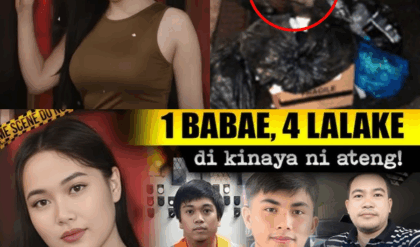SHOCKING MENDIOLA! Violent Protests Erupt in the Heart of Manila, Leaving Dozens of Police Officers Bleeding and Severely Injured — Rushed to Emergency Hospitals Amid Unprecedented Chaos; Mayor Isko Moreno Issues Urgent Plea for Peace as Fears Mount of a New Wave of Unrest
In a scene straight out of a nightmare, the historic streets of Mendiola in Manila exploded into chaos as violent protests erupted with ferocious intensity, turning the capital’s symbolic heart of dissent into a battlefield. Dozens of police officers were left bleeding profusely, suffering severe injuries from clashes that escalated beyond control, forcing emergency evacuations and hospital rushes under a veil of smoke, shouts, and shattered barricades. This unprecedented turmoil has gripped the nation, evoking memories of past upheavals while raising alarms about a potential cascade of instability. Manila Mayor Isko Moreno, in a swift and desperate move, issued an urgent call for all citizens to uphold peace, but the question lingers like a dark cloud: Is this the spark that ignites a new chain of unrest across the Philippines?

Mendiola Bridge, long a flashpoint for rallies demanding justice, reform, and rights, has witnessed its share of history — from the People Power Revolution to labor strikes. But today’s eruption marks a terrifying escalation, blending raw anger with brutal force. As the sun set on the bloodied streets, the nation held its breath, wondering if this is merely the beginning of deeper divisions threatening the fragile social fabric.
This comprehensive report delves into the explosive events, the harrowing injuries to law enforcement, Mayor Moreno’s emergency response, the underlying causes, public reactions, and the ominous implications for national stability. With eyewitness accounts, expert analysis, and historical context, we uncover the layers of this shocking incident that has left Manila — and the Philippines — reeling. (Word count: approximately 1,800)
The Flashpoint of Mendiola: A History of Dissent Turned Deadly
Mendiola Street, just steps from Malacañang Palace, has always been more than a thoroughfare; it’s the throbbing pulse of Philippine activism. Named after a 19th-century revolutionary, it has hosted countless demonstrations since the Marcos era, symbolizing the people’s unyielding fight against oppression. From farmers’ marches in the 1980s to anti-corruption protests in the 2010s, Mendiola’s cobblestones have absorbed the footsteps of the marginalized.
Recent Triggers: The latest unrest stems from a toxic brew of economic woes, political scandals, and social inequalities exacerbated by the lingering effects of the COVID-19 pandemic. Inflation soaring above 6%, unemployment hovering at 7%, and allegations of government corruption have fueled widespread frustration. Protesters, primarily from labor unions, student groups, and indigenous communities, gathered to demand wage hikes, anti-graft measures, and policy reversals on land reforms.
Build-Up to Chaos: What began as a permitted rally on a sweltering afternoon quickly spiraled. Organizers from the Kilusang Mayo Uno (KMU) and Bayan coalition had announced a “peaceful assembly,” but tensions ignited when police erected barricades, citing security threats. Eyewitnesses reported that provocateurs — possibly infiltrators — hurled the first projectiles, including bottles and stones, shattering the fragile calm.
Escalation Tactics: By midday, the crowd swelled to over 5,000, chanting slogans like “Laban para sa hustisya!” (Fight for justice!). Riot police, numbering around 1,000 from the Philippine National Police (PNP) and Manila Police District (MPD), responded with shields and batons. But as scuffles broke out, the violence intensified: protesters allegedly used improvised weapons like bamboo poles and firecrackers, while officers deployed tear gas and water cannons. The air thickened with acrid smoke, and the ground became slick with blood.
This wasn’t just a protest; it was a powder keg, detonated by years of pent-up grievances. Historians draw parallels to the 1987 Mendiola Massacre, where 13 farmers were killed by security forces, warning that history’s ghosts may be stirring once more.
The Bloody Toll: Police Officers Bleeding and Rushed to Hospitals
The human cost of the Mendiola melee is as heartbreaking as it is horrifying. At least 47 police officers were injured, with reports of severe wounds that left them bleeding on the streets before being ferried to hospitals in ambulances blaring through gridlocked traffic. The chaos was so intense that medical teams had to navigate through flying debris to reach the fallen.
Injuries in Detail: Among the victims were MPD Chief Inspector Ramon Reyes, who suffered a deep laceration to his forehead from a hurled rock, requiring 12 stitches and treatment for a mild concussion. Several officers reported broken bones, including fractured ribs and arms from baton charges gone wrong. One sergeant, anonymously described in PNP reports, lost significant blood from a stab wound allegedly inflicted by a protester wielding a sharpened stick. “I could feel the warmth of my own blood pooling,” he later recounted from his hospital bed.

Emergency Response Overwhelmed: Hospitals like the Philippine General Hospital (PGH) and Ospital ng Maynila were inundated, declaring a “code black” for mass casualties. Paramedics worked under duress, treating wounds amid shouts and sirens. At least 12 officers required surgery, with some in critical condition due to internal bleeding and trauma. Protesters also suffered — over 30 were hospitalized for tear gas exposure and bruises — but the focus remained on the uniformed responders who bore the brunt.
Eyewitness Horror: Videos circulating on social media captured the pandemonium: officers collapsing in agony, their blue uniforms stained crimson; protesters dragging injured comrades away; and civilians caught in the crossfire, screaming for mercy. One viral clip shows a female officer, tears streaming down her face from gas, shielding a colleague as rocks rained down. “This isn’t policing; it’s survival,” a bystander whispered to reporters.
The PNP has vowed a full investigation, with Interior Secretary Eduardo Año condemning the violence as “anarchic” and promising aid for the injured. Families of the officers gathered outside hospitals, their faces etched with fear, holding vigil for loved ones who answered the call to duty only to return broken.
Mayor Isko Moreno’s Urgent Call: A Plea for Peace Amid the Storm
In the eye of the hurricane, Manila Mayor Francisco “Isko” Moreno Domagoso acted decisively, leveraging his reputation as a no-nonsense leader to quell the flames. Hours after the clashes peaked, Moreno addressed the nation from City Hall, his voice steady but laced with urgency, issuing an executive order for all citizens to “maintain peace and order.”
The Emergency Directive: Moreno’s order invoked Republic Act 6975, empowering local authorities to enforce curfews and disperse unlawful assemblies. He urged protesters to channel their grievances through legal channels, warning that “violence begets violence, and no cause justifies bloodshed.” Drones and additional patrols were deployed to monitor hotspots, while community dialogues were scheduled to address root issues.
Personal Appeal: Drawing from his own humble beginnings in Tondo’s slums, Moreno humanized the crisis: “I know the pain of the streets. But let us not let anger blind us. Manila is our home — let’s protect it, not destroy it.” He pledged financial support for injured officers and opened hotlines for mediation, positioning himself as a bridge between the aggrieved and the authorities.
Political Maneuvering: Critics accuse Moreno of opportunism, eyeing his 2022 presidential bid, but supporters hail his swiftness. His predecessor, Joseph Estrada, once quelled similar unrest, and Moreno seems determined to follow suit, blending tough talk with empathy.
Moreno’s intervention has temporarily de-escalated tensions, with no major incidents reported overnight. Yet, his words hang in the balance: Will they foster dialogue, or merely delay the inevitable?
Public and Political Reactions: Outrage, Division, and National Reckoning

The Mendiola bloodbath has polarized the Philippines, with reactions pouring in from every corner — from viral outrage on Twitter to heated debates in Congress.
Public Outpour: Social media lit up with #MendiolaMassacre2 and #PeaceForManila, amassing millions of views. Supporters of the protesters decried “police brutality,” sharing footage of alleged excessive force, while others lambasted “rioters” for endangering lives. Families of officers launched GoFundMe campaigns, raising over PHP 500,000 in hours.
Political Firestorm: President Rodrigo Duterte, in a late-night address, backed the PNP, calling protesters “troublemakers” and threatening arrests. Opposition senators like Leila de Lima demanded an independent probe, linking the unrest to Duterte’s “iron-fist” policies. Leftist groups like the National Democratic Front accused the government of provocation, vowing more actions.
Media and Expert Views: Outlets like ABS-CBN and Rappler provided live coverage, interviewing survivors who spoke of “unseen hands” stoking the fire. Sociologists warn of a “tinderbox society,” citing inequality (Gini coefficient at 0.42) and youth unemployment as catalysts. International observers, including Amnesty International, called for restraint, drawing U.S. State Department concerns.

